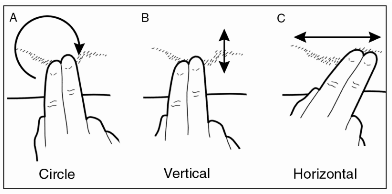Though there is no treatment that will perfectly prevent scar formation, the techniques and treatments mentioned here can help diminish their appearance.
Scars are formed as the body repairs skin wounds caused by surgery, accident, or disease. They are a natural and unavoidable part of the healing process. The longer it takes a wound to heal or the more damaged the skin was the greater the chance of developing a noticeable scar. Factors that affect scar formation include: skin type, genetics, location on the body and age. Older skin tends to scar less visibly while younger skin occasionally may over heal which can result in thicker scars.
Tips to minimize scar formation after surgery: Starting about 10 days (range from 8-12 days) after your sutures have been removed you can begin massaging the scar. Scar massage has been shown to be an effective way to decrease scar tissue and make scars less noticeable. It works by promoting collagen remodeling, decreasing itch, and providing moisture and flexibility to the scar.
 Scar massage should be done 2-3 times a day for 30 seconds- 5 minutes each time.
Scar massage should be done 2-3 times a day for 30 seconds- 5 minutes each time.
Massage the scars in a circular, vertical and horizontal fashion. Apply as much pressure as you can tolerate. Scar massage can be done for 2-3 months following your procedure.
Silicone Gels/Strips
Application of silicone to scars can help minimize the redness, hardness, and elevation associated with some scars. Silicone helps reduce scar appearance by:
- Increasing hydration to the top layer of skin which helps reduce collagen production and protects scarred tissue from bacteria which can cause excessive collage production, and increases the levels of enzymes that break down collagen
- Reduce itching and discomfort associated with scars.
There are a variety of silicone gel and silicone strip products that are available on the market. Strips and gels appear to have similar efficacy but differ in their application.
Below are some examples of available products:
- Kelo-cote gel or spray- kelocote.com/default.asp
- NewGel strips or ointment- newgelplus.com/
- Scar Away strips-myscaraway.com/index.html
- Epi-derm gel strips- biodermis.com/scar-products/epi-derm/
- BioCorneum gel- biocorneum.com/
The silicone strips come in many different sizes and styles. Some are clear, allowing them to blend in better with your natural skin color. Others are a skin color cloth type which lasts longer while others have fun designs that kids may enjoy. The strips can be cut to fit the size of your scar.
How to use silicone strips:
- Cut strip to size of the scar.
- Place strip on the area of the scar, wear for 6-23 hours a day.
- When done, wash the strip so dirt does not build up (don’t throw away nightly)
- The strips are reusable and should be replaced every 1-3 weeks when the adhesive is gone.
How to use silicone gels:
- Massage gel onto the scar and allow to dry (typically 1-2 minutes). Reapply the gel 2-3 times a day and after every shower/bath/ or swimming.
- With both products, the longer you have the silicone in contact with the scar each day, the better. It is recommended to use the silicone strips/gel for a minimum of 3 months (ideally 2-3 months or more) with improvement being noticed up to 6 months.
Summary: Apply silicone strips at least over night for 2-3 months to get the best results (10-20% scar improvement). Silicone gels may be used during the day, but overall strips are slightly better. Using a combination of the two is a great treatment as well.
Other Treatment Options
- Vitamin E treatment can help improve the appearance scars; however, the benefit most likely comes from being hydrated from the oil. More evidence is needed to recommend this over other treatments.
- Mederma is another company that offers products to help with scar reduction. These may help to a small degree, but again more evidence is needed to truly recommend this.
- Some scars get small blood vessels (telangiectasias) surrounding them. Vascular laser or an epilating needle (fine acupuncture-like needle) can be used to effectively heat up and shrink these.
- Scar revision: some scars may need surgical excision which will leaving a smaller scar in its place.
Hypertrophic scars can form when there is a lot of tension on the scar. They do not need to be treated but an injection of cortisone directly into the scar can help soften and flatten them.
Sometimes the scar will spontaneously develop into large scar known as a keloid. Keloids are different from hypertrophic scars as they grow past the original scar edges. Keloids can arise soon after the injury or develop months later and can be uncomfortable or itchy.
While most people never form keloids, others develop them after minor injuries, even insect bites or pimples. Keloids may form anywhere, though the upper chest and shoulders are common locations. Dark skinned individuals form keloids more easily than light skinned individuals.
Dermabrasion for scar revision
Dermabrasion is a procedure that removes the upper layers of skin, stimulating new skin growth that can diminish the appearance of scars. This is a common treatment option for acne scarring.
In addition to dermabrasion, various creams and laser treatments can also reduce the appearance of scars that have already formed.


